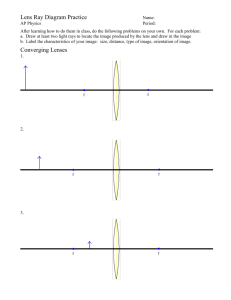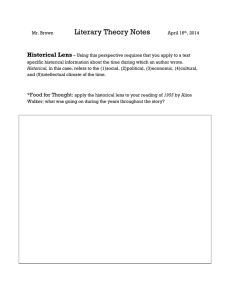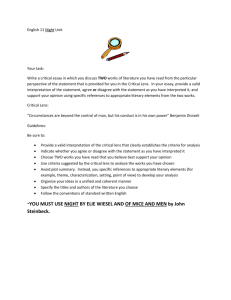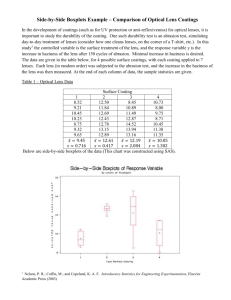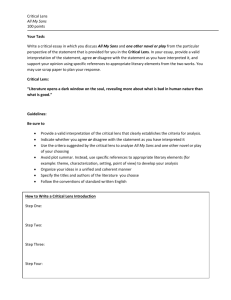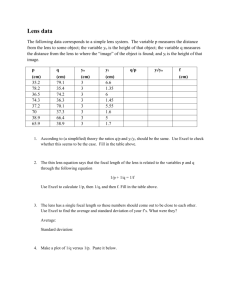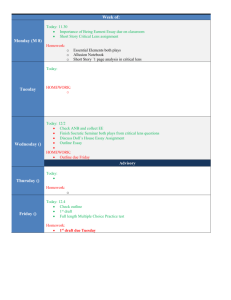OPT 2500 - Florida State College at Jacksonville
advertisement
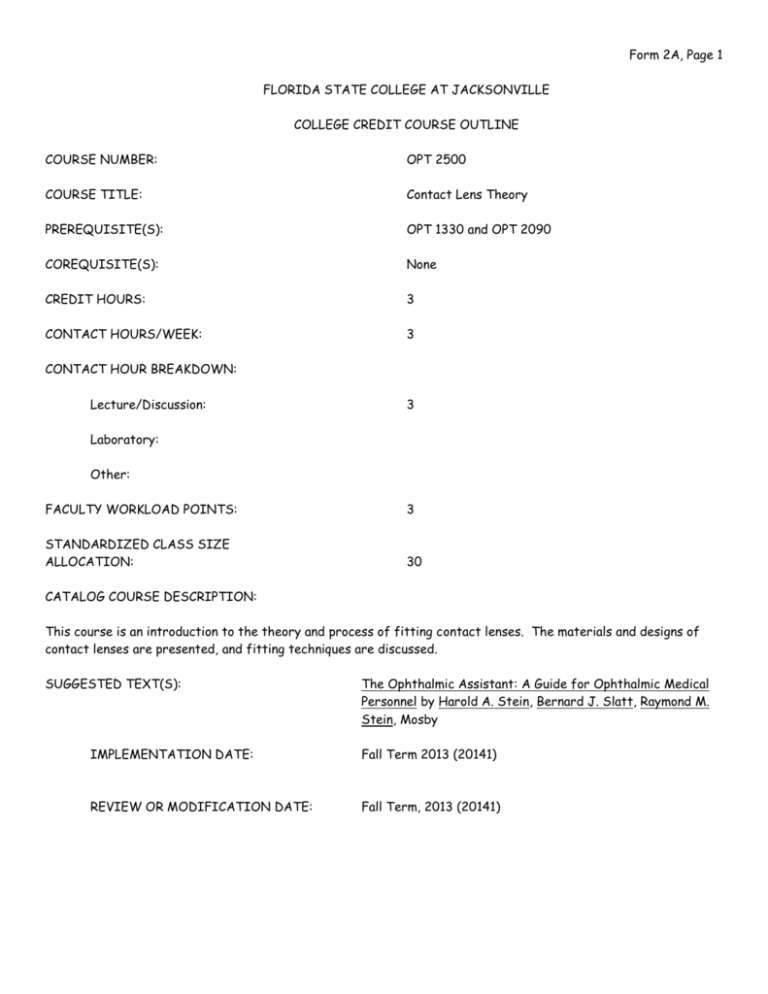
Form 2A, Page 1 FLORIDA STATE COLLEGE AT JACKSONVILLE COLLEGE CREDIT COURSE OUTLINE COURSE NUMBER: OPT 2500 COURSE TITLE: Contact Lens Theory PREREQUISITE(S): OPT 1330 and OPT 2090 COREQUISITE(S): None CREDIT HOURS: 3 CONTACT HOURS/WEEK: 3 CONTACT HOUR BREAKDOWN: Lecture/Discussion: 3 Laboratory: Other: FACULTY WORKLOAD POINTS: 3 STANDARDIZED CLASS SIZE ALLOCATION: 30 CATALOG COURSE DESCRIPTION: This course is an introduction to the theory and process of fitting contact lenses. The materials and designs of contact lenses are presented, and fitting techniques are discussed. SUGGESTED TEXT(S): The Ophthalmic Assistant: A Guide for Ophthalmic Medical Personnel by Harold A. Stein, Bernard J. Slatt, Raymond M. Stein, Mosby IMPLEMENTATION DATE: Fall Term 2013 (20141) REVIEW OR MODIFICATION DATE: Fall Term, 2013 (20141) Form 2A, Page 2 COURSE TOPICS CONTACT HOURS ___PER TOPIC____ I. Historical Development of Contact Lenses 3 II. Contact Lens Terminology 3 III. Indications for Contact Lens Fitting 3 IV. Ocular Anatomy and Physiology Related to Contact Lens Fitting 3 V. Contact Lens Design 3 VI. Contact Lens Material 3 VII. Optical Principles of Contact Lenses 3 VIII. Rigid Gas Permeable Contact Lens Fitting 3 IX. Soft Contact Lens Fitting Procedures 3 X. Toric Contact Lenses 3 XI. Monovision and Multifocal Contact Lenses 3 XII. Contact Lens Solution 3 XIII. Patient Education 3 XIV. Contact Lens Related Problems 3 XV. Follow-Up Evaluation 3 45 Form 2A, Page 3 PROGRAM TITLE: Ophthalmic Technician COURSE TITLE: Contact Lens Theory CIP NUMBER: 1351180301 Florida Department of Education Student Performance Standards 02.0 Demonstrate the ability to communicate and use interpersonal skills effectively–The student will be able to: 02.01 Develop basic speaking and active listening skills. 02.02 Develop basic observational skills and related documentation strategies in written and oral form. 02.03 Identify characteristics of successful and unsuccessful communication including communication styles and barriers. 02.04 Respond to verbal and non-verbal cues. 02.05 Compose written communication using correct spelling, grammar, a formatting and confidentiality and specific formats of letter writing. 02.06 Use appropriate medical terminology and abbreviations. 02.07 Recognize the importance of courtesy and respect for patients and other healthcare workers and maintain good interpersonal relationships. 02.08 Recognize the importance of patient/client educations regarding healthcare. 02.09 Adapt communication skills to varied levels of understanding and cultural orientation including diverse age, cultural, economic, ethnic and religious groups. 02.10 Analyze elements of communication using a sender-receiver model. 02.11 Distinguish between and report subjective and objective information. 02.12 Report relevant information in order of occurrence. 05.0 Recognize and practice safety and security procedures–The student will be able to: 05.01 05.02 05.03 05.04 05.05 05.06 05.07 05.08 05.09 05.10 05.11 05.12 11.0 Recognize safe and unsafe working conditions and report safety hazards. Demonstrate the safe use of medical equipment. Explain and apply the theory of root- cause analysis. Identify and describe methods in medical error reduction and prevention in the various healthcare settings. Identify and practice security procedures for medical supplies and equipment. Demonstrate personal safety procedures based on Occupations Safety and Health Administration (OSHA) and Centers for Disease Control (CDC) regulations (including standard precautions). Recognize Materials Data Safety Sheets (MSDS) and comply with safety signs, symbols and labels. Demonstrate proper body mechanics and ergonomics. Demonstrate the procedure for properly identifying patients. Demonstrate procedures for the safe transport and transfer of patients. Describe fire, safety, disaster and evacuations procedures. Discuss The Joint Commission patient safety goals (www.jointcommission.org). Apply basic math and science skills–The student will be able to: 11.01 11.02 Draw, read, and report on graphs, charts and tables. Measure time, temperature, distance, capacity, and mass/weight. 11.03 11.04 11.05 11.06 11.07 11.08 11.09 17.0 Make, use and convert using both traditional and metric units. Make estimations and approximations and judge the reasonableness of the result. Convert from regular to 24 hour time. Demonstrate ability to evaluate and draw conclusions. Organize and communicate the results obtained by observation and experimentation. Ask appropriate scientific questions and recognize what is involved in experimental approaches to the solution of such questions. Calculate ratios. Demonstrate the instruction of the patient in personal eye care and in the use of contact lenses–The student will be able to: 17.01 17.02 Instruct the patient in the correct methods of insertion and removal of the contact lenses. Instruct the patient in the appropriate methods of daily care of the eye and the contact lenses. Student Performance Standards CoA-omp Accreditation Standards Course Overview: Historical Development of Contact Lenses Course Outcome: 1.0 The student will be able to discuss the history of contact lens development and the progression of contact lens design to the present Specific Learning Objectives: Upon completion of this unit, the student will be able to: 1.1 List the early scientific research and development in the contact lens field 1.2 Describe the contact lens fitting procedure by casting the anterior segment 1.3 Discuss the materials used in early contact lenses fitting and manufacture 1.4 Describe the historical development of rigid contact lenses 1.5 Discuss the historical development of soft contact lenses Course Overview: Contact Lens Terminology Course Outcome: 2.0 The student will be able to define terminology and abbreviations associated with contact lens design and fitting. Specific Learning Objectives: Upon completion of this unit, the student will be able to: 2.1 Define terms related to contact lens materials 2.2 Define terms related to contact lens design 2.3 Discuss terms used in contact lens fitting 2.4 Used abbreviations related to contact lens 2.5 Define the DK value 2.6 Differentiate between diopters and mm of radius 2.7 Define the wetting angle of a contact lens 2.8 Discuss oxygen permeability Course Overview: Indications for Contact lens Fitting Course Outcome: 3.0 The student will be able to discuss diagnoses and indications for contact lens fitting Specific Learning Objectives: Upon completion of this unit, the student will be able to: 3.1 Discuss spherical refractive errors and contact lens fitting 3.2 Describe astigmatic refractive errors and contact lens fitting 3.3 Describe soft contact lens material 3.4 Discuss corneal pathology and contact lens fitting 3.5 Discuss the indications for bandage contact lens use 3.6 List contraindications for contact lens fitting Course Overview: Ocular Anatomy and Physiology Related to Contact Lens Fitting Course Outcome: 4.0 Student will review the anatomy and physiology of the eyelids, anterior segment and tear film as it related to contact lens wear 2.0 Specific Learning Objectives: Upon completion of this unit, the student will be able to: 4.1 Describe the function of the eyelids in contact lens movement 4.2 Discuss the structures of the ocular surface 4.3 Describe the function of the bulbar and palpebral conjunctiva 4.4 List the layers of the cornea and discuss the function of each layer 4.5 Describe the pre-corneal tear film Course Overview: Contact Lens Design Course Overview: 5.0 The student will be able to describe the components of a contact lens Specific Learning Objectives: Upon completion of this unit, the student will be able to: 5.1 Describe the optic zone 5.2 Describe the total diameter 5.3 Define the primary base curve 5.4 Discuss the peripheral curves 5.5 Describe a lenticular bowl and carrier 5.6 Describe scleral lens design 5.7 Discuss hybrid/skirted lens design Course Outcome: Contact Lens Materials Course Outcome: 6.0 This unit will introduce different materials used in the manufacture of contact lenses Specific Learning Objectives: Upon completion of this unit, the student will be able to: 6.1 Discuss the use of polymethymethacrylate 5.1 Discuss materials used in rigid gas permeable lenses 5.2 Describe materials used in soft contact lenses Course Overview: Fitting Contact Lenses Course Outcome: 7.0 The student will be able to discuss the measurements and evaluations necessary to fit gas permeable or soft contact lenses Specific Learning Objectives: Upon completion of this unit, the student will be able to: 7.4 Discuss refractometry measurements 7.5 Transpose spherocylinder lens powers to minus cylinder format 7.6 Describe measurements of the corneal surface 7.7 Discuss the quality of the tear film 7.8 Describe the blink reflex as it relates to contact lens wear 7.9 Discuss the influence of the vertex distance and the pre-corneal tear film in the final contact lens power Course Overview: Rigid Gas Permeable Contact Lens Fitting Specific Learning Objectives: Upon completion of this unit, the student will be able to: 8.1 Discuss the indications for rigid gas permeable contact lens fitting 8.2 Describe the sagittal depth 8.3 Discuss the role of the tear film and optical power (SAMFAP) 8.4 Discuss the role of the diameter and the optical power 8.5 Describe fluorescein patterns of steep or flat lens fitting 8.6 Discuss corneal changes associated with rigid contact lens wear 8.7 Describe spectacle blur 8.8 Discuss orthokeratology/corneal refractive therapy 8.9 Discuss the adaptation period for new rigid contact lens wearers Course Overview: Soft Contact Lens Fitting Course Outcome: 9.0 This unit will introduce the student to soft contact lens fitting techniques Specific Learning Objectives: Upon completion of this unit, the student will be able to: 9.1 Discuss the indications for soft contact lens fitting 9.2 Differentiate between lathe cut and injection molded lens manufacture 9.3 Discuss the role of the tear film in soft lens wear 9.4 Discuss the role of the eyelids in soft contact lens movement 9.5 Describe corneal changes associated with soft contact lens wear 9.6 Describe conjunctival changes associated with soft contact lens wear 9.7 9.8 9.9 Describe methods of evaluation of soft contact lens fit Differentiate between daily and extended contact lens wear Discuss daily, weekly and monthly replacement of soft contact lenses Course Overview: Tori Contact Lenses Course Outcome: 10.0 The student will be able to describe correction of astigmatism with contact lenses Specific Learning Objectives: Upon completion of this unit, the student will be able to: 10.1 Calculate the corneal and lenticular components of an astigmatic error 10.2 Describe the indication for a front toric rigid contact lens 10.3 Describe the indications for a back toric rigid contact lens 10.4 Describe the use of a bitroic rigid contact lens 10.5 Discuss the indications for a soft toric contact lens 10.6 Describe methods of stabilization of toric contact lenses 10.7 Discuss toric markers on soft contact lenses (LARS) Course Overview: Monovision and Multifocal Contact Lenses Course Outcome: 11.0 The student will be able to discuss correction of near vision problems with contact lenses Specific Learning Objectives: Upon completion of this unit, the student will be able to: 11.1 Discuss presbyopia 11.2 Describe monovision contact lens wear 11.3 Discuss modified monovision contact lens fitting 11.4 Describe the translating design for bifocal contact lenses 11.5 Differentiate between concentric and aspheric multifocal contact lens design Course Overview: Contact Lens Solutions Course Outcome: 12.0 The student will be able to discuss solutions used for contact lens cleaning, disinfection, storage and rehydration. Specific Learning Objectives: Upon completion of this unit, the student will be able to: 12.1 Describe storage solutions for rigid gas permeable contact lenses 12.2 Discuss cleaning solutions for rigid gas permeable contact lenses 12.3 Describe solutions for disinfection for soft contact lenses 12.4 Discuss solutions for storage and hydration of soft contact lenses 12.5 Describe solutions and products used to clean soft contact lenses 12.6 Discuss the use of enzymatic cleaners for soft contact lenses Course Overview: Patient Education Course Outcome: 13.0 The student will be able to instruct the patient on contact lens wear and care Specific Learning Objectives: Upon completion of this unit, the student will be able to: 13.1 Describe personal hygiene concerns with contact lens wear 13.2 Describe care of contact lens cases and supplies 13.3 Discuss cleaning and disinfection of rigid gas permeable contact lenses 13.4 Describe cleaning and disinfection of soft contact lenses 13.5 List steps of insertion and removal of rigid gas permeable contact lenses 13.6 List the steps of insertion and removal of soft contact lenses 13.7 Discuss the wearing schedule for rigid and soft contact lenses Course Overview: Contact Lens Related Problems Course Outcome: 14.0 The student will be able to discuss ocular pathology related to rigid gas permeable and soft contact lens wear Specific Learning Objectives: Upon completion of this unit, the student will be able to: 14.1 14.2 14.3 14.4 Describe corneal ulcers associated with contact lens wear Discuss corneal neovascularization associated with contact lens wear Describe conjunctival changes associated with contact lens wear Discuss corneal and conjunctival pathology associated with contact lens solutions Course Overview Follow-Up Evaluation Course Outcome: 9.0 The student will be able to describe essential components of the contact lens follow-up evaluation Specific Learning Objectives Upon completion of this unit, the student will be able to: 9.1 9.2 9.3 9.4 15.5 Discuss visual acuity assessment and over-refractometry Describe the fluorescein pattern of a rigid contact lens fit Discuss movement of a soft contact lens Describe assessment of the palpebral conjunctiva Discuss assessment of the cornea and bulbar conjunctiva Florida State College At Jacksonville Course Learning Outcomes & Assessment NOTE: Use either the Tab key or mouse click to move from field to field. The box will expand to accommodate your entry. Section 1 SEMESTER CREDIT HOURS (CC): 3 CONTACT HOURS (NCC): COURSE PREFIX AND NUMBER: OPT 2500 COURSE TITLE: Contact Lens Theory Section 2 TYPE OF COURSE: (Click on the box to check all that apply) AA Elective AS Required Professional Course College Prep AS Professional Elective AAS Required Professional Course Technical Certificate Other PSAV Apprenticeship General Education: (For General Education courses, you must also complete Section 3 and Section 8) Section 3 (If applicable) INDICATE BELOW THE DISCIPLINE AREA FOR GENERAL EDUCATION COURSES: Communications Social & Behavioral Sciences Natural Sciences Humanities Mathematics Section 4 INTELLECTUAL COMPETENCIES: Reading Speaking Critical Analysis Writing Listening Information Literacy Quantitative Skills Ethical Judgment Scientific Method of Inquiry Working Collaboratively Section 5 STATE GENERAL EDUCATION LEARNING OUTCOME AREA Critical Communication Scientific and Quantitative Reasoning Thinking Information Global Sociocultural Responsibility Literacy Section 6 LEARNING OUTCOMES The student will be able to discuss the history of contact lens development and the progression 2 of contact lens design to the present The student will be able to define and abbreviations associated terminology 3 with contact lens design and fitting. The student will be able to discuss the diagnoses and indications for contact lens fitting The student will review the anatomy and physiology of the eyelids, anterior segment Type of Outcome: Gen. Ed, Program, Course METHOD OF ASSESSMENT Course Written examinations, projects Course Written examinations, projects Course Written examinations, projects Course Written examinations, projects and tear film as it related to contact lens wear The student will be able to describe the components of a contact lens The student will be able to discuss the measurements and evaluations necessary to fit gas permeable or soft contact lenses The student will be able to describe correction of astigmatism with contact lenses Course Written examination, projects Course Written examination, projects Course Written examination, projects Section 7 Name of Person Completing This Form: Pattie Lamell Date: 2/15/13
